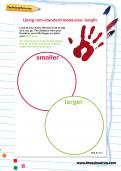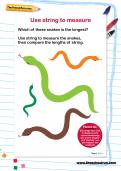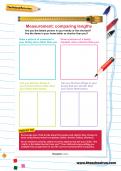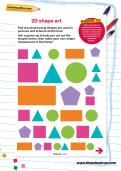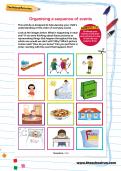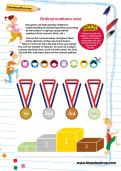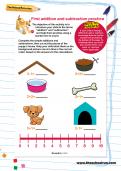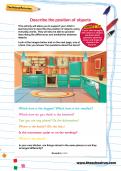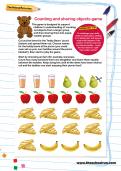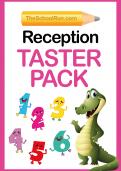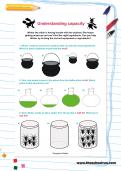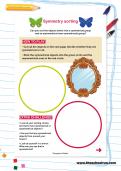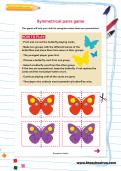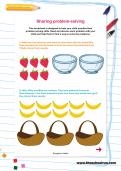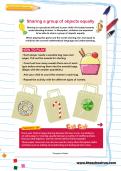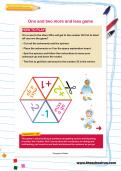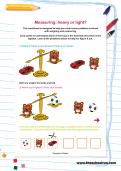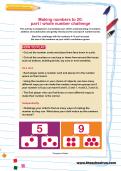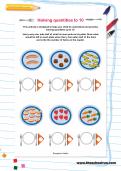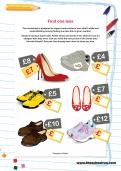Eyfs Maths worksheets
Free worksheets: Weights and measurements, EYFS, Reception
You’ll need to login or Register first to access these worksheets for free.
Once you’ve tried out our free worksheets, why not explore all our resources (1000s of worksheets, interactive tutorials, learning packs and more) with a 14-day FREE trial subscription.
Using non-standard measures: length
Let's get measuring. Look at your hand. Stretch it out as big as it can go. The distance from your thumb to your little finger is called your hand span. Go around your house finding things that are smaller and things that are larger than your hand span. Write them in these circles.
Use string to measure
This practical and fun activity will enable your child to measure the snakes with string and compare the lengths using mathematical language.
Measurement: comparing lengths
Are you the tallest person in your family or the shortest? Are the items in your home taller or shorter than you? Let's do some measuring to find out!
2D shape art
Flat two-dimensional shapes are used in pictures and artwork all the time. Ask a grown-up to help you cut out these shapes, then make your own shape masterpiece in the frame
Organising a sequence of events
This activity is designed to help develop your child’s understanding of the order of everyday events. Look at the images, which represent things that happen throughout the day, and see if you can order them correctly.
Ordinal numbers race
This racing game will help develop your child’s understanding of positioning items according to their place in a group using ordinal numbers (first, second, third, etc.).
First addition and subtraction practice
Complete the simple additions and subtractions, then cut out the pieces of the puppy’s house. Help your child stick them on the background picture one at a time in the correct order, based on the answers to the calculations.
Describe the position of objects
Can you find all the items in these images. You'll need to use words like 'in', 'on' and 'under'.
Counting and sharing objects game
This Teddy Bears’ picnic game is designed to support children’s understanding of counting out objects from a larger group and then sharing them into equal, smaller groups.
Reception worksheets taster pack
Find out what your child will learn in Reception English, maths and science, try out a few learning activities and read our top tips about how to support their learning and development in our free, downloadable Reception Taster Pack.
Understand and use the vocabulary of distance
This activity is designed to help your child understand and use the vocabulary of distance and to practise solving practical problems.
Symmetry sorting
Help your child sort the objects into a symmetrical group and an asymmetrical (non-symmetrical) group to consolidate their knowledge of symmetry.
Symmetrical pairs game
This butterfly playing cards game will help your child to recognise when items are symmetrical.
Sharing problem-solving
This worksheet is designed to help your child practise their division problem-solving skills.
Sharing a group of objects equally
Sharing is a practical skill and is your child’s first step towards understanding division. In Reception, children are expected to be able to share a group of objects equally.
One Less Board Game: numbers 0-20
This game is designed to help your child practise the skill of finding one less than a given number.
One and two more and less game
This game is about looking at numbers and getting used to moving along a number line / ladder. Don’t worry about the vocabulary of adding and subtracting, just count on and back and discuss the numbers as you go. It’s a race to the stars!
Measuring: heavy or light?
This worksheet is designed to help your Reception child solve first weighing and measuring problems.
Making numbers to 20: part / whole number challenge
This activity is designed to consolidate your child’s understanding of numbers, addition and subtraction and gently introduces the concept of number bonds.
Halving quantities to 20
This activity is designed to help your child to understand and practise halving quantities up to 20.
Halving quantities to 10
This activity is designed to help your child to understand and practise halving quantities up to 10.
Find one less
This worksheet is designed to support and reinforce your Reception child’s skills and understanding around finding one less than a given number.
